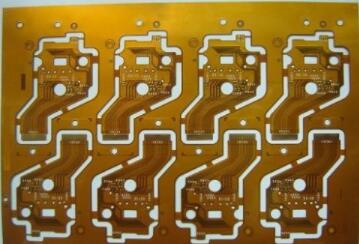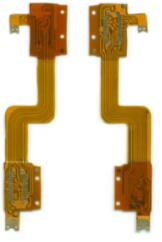The types and structure of FPC flexible circuit boards made by flexible circuit boards are divided according to the combination of the base material of flexible circuit boards and copper foil. Flexible circuit boards can be divided into two types: flexible circuit boards with glue and flexible circuit boards without glue. The structure is divided into It is single-sided flexible circuit board, double-sided flexible board, multi-layer flexible board, rigid-flex board, etc.
With the rapid development of science and technology and the continuous advancement of human high technology, FPC flexible circuit boards are used more and more. For example, FPC flexible circuit boards used in laptops and smart phones are the most common, and various electronic products are different. The type of FPC flexible circuit board used in the base and the structure of the flexible circuit board are also different.
First of all, according to the combination of the base material of the flexible board and the copper foil, the flexible circuit board can be divided into two types:
Adhesive flexible circuit board and non-adhesive flexible circuit board
Among them, the price of glueless flexible circuit boards is much higher than that of glued flexible boards, but its flexibility, the bonding force of the copper foil and the substrate, and the flatness of the pads are also better than glued flexible boards. Therefore, it is generally only used for high-demand occasions, such as: COF (CHIP ON FLEX, bare chip mounted on flexible board, high requirements for flatness of the pad) and so on.

Due to its high price, most of the flexible boards currently used in the market are still flexible boards with glue.
Next we will introduce and discuss flexible boards with glue. Since the flexible board is mainly used in occasions that need to be bent, if the design or process is unreasonable, defects such as micro-cracks and open welding are likely to occur. The following is about the structure of the flexible circuit board and its special requirements in design and technology.
Let's look at the structure of the flexible circuit board
According to the number of layers of conductive copper foil, it is divided into single-sided flexible circuit boards, double-sided flexible boards, multilayer flexible boards, and rigid-flex boards.
Single-sided flexible circuit board structure: The flexible board of this structure is the simplest flexible board. Usually the base material + transparent glue + copper foil is a set of purchased raw materials, and the protective film + transparent glue is another purchased raw material. First, the copper foil needs to be etched and other processes to obtain the required circuits, and the protective film needs to be drilled to expose the corresponding pads. After cleaning, use the rolling method to combine the two. Then the exposed pad part is electroplated with gold or tin for protection. In this way, the slab is ready. Generally, small flexible circuit boards of corresponding shapes are also stamped.
There are also solder masks directly printed on the copper foil without a protective film, so the cost will be lower, but the mechanical strength of the circuit board will be worse. Unless the strength requirements are not high but the price needs to be as low as possible, it is best to apply a protective film method.
The structure of the double-sided flexible circuit board: When the circuit of the FPC circuit board is too complicated, the single-layer board cannot be wired, or the copper foil is required for grounding shielding, it is necessary to use a double-layer board or even a multilayer board structure.
The most typical difference between a multi-layer board and a single-layer board is the addition of a via structure to connect each layer of copper foil. The first processing technology of general substrate + transparent glue + copper foil is to make vias. First drill holes on the substrate and copper foil, and then plate a certain thickness of copper after cleaning, and the vias are completed. The subsequent production process is almost the same as the single-layer board.
Double-sided board structure: There are pads on both sides of the double-sided board, which are mainly used for connection with other circuit boards. Although it is similar to the single-layer board structure, the manufacturing process is very different. Its raw material is copper foil, protective film + transparent glue. First, drill holes on the protective film according to the requirements of the pad position, and then paste the copper foil to corrode the pads and leads, and then paste another drilled protective film.
The performance and selection method of flexible circuit board materials
(1), FPC base material:
The commonly used material for flexible circuit boards is polyimide (POLYMIDE), which is a high-temperature, high-strength polymer material. It is a polymer material invented by DuPont, and the polyimide produced by DuPont is called KAPTON. You can also buy some polyimides produced in Japan at a lower price than DuPont.
It can withstand a temperature of 400 degrees Celsius for 10 seconds, and its tensile strength is 15,000-30,000 PSI.
The 25μm thick FPC substrate is the cheapest and the most common application. If the flexible circuit board needs to be harder, a 50μm substrate should be used. Conversely, if the flexible circuit board needs to be softer, a 13μm substrate is used.
(2) Transparent glue for FPC substrate:
There are two types of epoxy resin and polyethylene, both of which are thermosetting adhesives. The strength of polyethylene is relatively low. If you want the circuit board to be softer, choose polyethylene.
The thicker the substrate and the transparent glue on it, the harder the circuit board. If the circuit board has a relatively large bending area, you should try to use a thinner substrate and transparent glue to reduce the stress on the surface of the copper foil, so that the chance of micro-cracks in the copper foil is relatively small. Of course, for such areas, single-layer boards should be used as much as possible.

(3) FPC copper foil:
There are two types: rolled copper and electrolytic copper. Rolled copper has high strength and bending resistance, but the price is more expensive. The price of electrolytic copper is much cheaper, but its strength is poor and it is easy to break. It is generally used in occasions where it is rarely bent.
The thickness of the copper foil should be selected according to the minimum lead width and minimum spacing. The thinner the copper foil, the smaller the minimum achievable width and spacing.
When choosing rolled copper, pay attention to the rolling direction of the copper foil. The rolling direction of the copper foil should be the same as the main bending direction of the circuit board.
(4) Protective film and its transparent glue:
Similarly, a 25μm protective film will make the flexible circuit board harder, but the price is cheaper. For circuit boards with relatively large bends, it is best to choose a 13μm protective film.
Transparent glue is also divided into epoxy resin and polyethylene, and the circuit board using epoxy resin is relatively hard. After the hot pressing is completed, some transparent glue will be extruded from the edge of the protective film. If the size of the pad is larger than the opening size of the protective film, the extruded glue will reduce the size of the pad and cause its edges to be irregular. At this time, transparent glue with a thickness of 13μm should be used as much as possible.
(5), pad plating:
For circuit boards with relatively large bending and exposed pads, electroplated nickel + electroless gold layer should be used, and the nickel layer should be as thin as possible: 0.5-2μm, and the chemical gold layer 0.05-0.1μm.
Shape design of pads and leads
(1). SMT pad:
--Common pad:
Prevent the occurrence of microcracks.
--Reinforced pad:
If the pad strength is required to be very high or an enhanced design is required.
--LED pad:
Due to the high requirements for the position of the LED and often stress during the assembly process, the pads of the LED should be specially designed.
-QFP, SOP or BGA pads:
Due to the greater stress of the pads on the corners, a reinforced design should be made.
(2). lead:
--In order to avoid stress concentration, the lead should avoid right-angle corners, but should use arc-shaped corners.
--The leads near the corners of the circuit board shape should be designed as follows to avoid stress concentration:
External interface design
(1) The circuit boar d design at the solder hole or plug:
Since the welding hole or the plug is subject to greater stress during the insertion operation, a reinforced design should be made to avoid cracks.
Use reinforcing plates to increase the hardness of the flexible circuit board welding hole plugs, the thickness is generally 0.2-0. 3mm, and the material is polyimide, PET or metal. For pad plating, it is best to choose electroplated nickel + hard gold for plugs, and electroplated nickel + chemical gold for solder holes.
(2) The design of the hot-press welding place:
It is generally used for the connection of two flexible circuit boards or flexible circuit boards and rigid printed circuit boards. It is generally called a flexible-hard combined circuit board or a rigid-flexible combined circuit board. Different industries have different names. When the circuit board needs to be bent near the hot-pressing area, polyimide tape or glue should be applied to this area to protect it to prevent the pad root of the flexible circuit board from breaking.